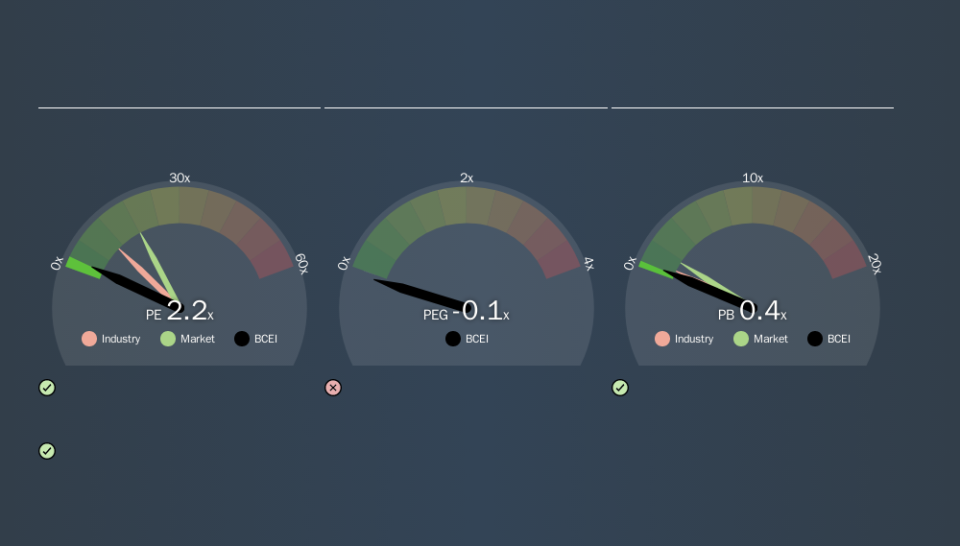Here's How P/E Ratios Can Help Us Understand Bonanza Creek Energy, Inc. (NYSE:BCEI)

This article is for investors who would like to improve their understanding of price to earnings ratios (P/E ratios). We'll show how you can use Bonanza Creek Energy, Inc.'s (NYSE:BCEI) P/E ratio to inform your assessment of the investment opportunity. Based on the last twelve months, Bonanza Creek Energy's P/E ratio is 2.22. In other words, at today's prices, investors are paying $2.22 for every $1 in prior year profit.
Check out our latest analysis for Bonanza Creek Energy
How Do I Calculate A Price To Earnings Ratio?
The formula for price to earnings is:
Price to Earnings Ratio = Share Price ÷ Earnings per Share (EPS)
Or for Bonanza Creek Energy:
P/E of 2.22 = $19.01 ÷ $8.55 (Based on the trailing twelve months to September 2019.)
Is A High Price-to-Earnings Ratio Good?
A higher P/E ratio means that investors are paying a higher price for each $1 of company earnings. All else being equal, it's better to pay a low price -- but as Warren Buffett said, 'It's far better to buy a wonderful company at a fair price than a fair company at a wonderful price.
Does Bonanza Creek Energy Have A Relatively High Or Low P/E For Its Industry?
The P/E ratio essentially measures market expectations of a company. If you look at the image below, you can see Bonanza Creek Energy has a lower P/E than the average (10.0) in the oil and gas industry classification.
This suggests that market participants think Bonanza Creek Energy will underperform other companies in its industry. While current expectations are low, the stock could be undervalued if the situation is better than the market assumes. It is arguably worth checking if insiders are buying shares, because that might imply they believe the stock is undervalued.
How Growth Rates Impact P/E Ratios
Earnings growth rates have a big influence on P/E ratios. That's because companies that grow earnings per share quickly will rapidly increase the 'E' in the equation. And in that case, the P/E ratio itself will drop rather quickly. So while a stock may look expensive based on past earnings, it could be cheap based on future earnings.
In the last year, Bonanza Creek Energy grew EPS like Taylor Swift grew her fan base back in 2010; the 211% gain was both fast and well deserved. Regrettably, the longer term performance is poor, with EPS down 48% per year over 5 years.
A Limitation: P/E Ratios Ignore Debt and Cash In The Bank
Don't forget that the P/E ratio considers market capitalization. That means it doesn't take debt or cash into account. In theory, a company can lower its future P/E ratio by using cash or debt to invest in growth.
Such spending might be good or bad, overall, but the key point here is that you need to look at debt to understand the P/E ratio in context.
Is Debt Impacting Bonanza Creek Energy's P/E?
Bonanza Creek Energy has net debt worth 18% of its market capitalization. This could bring some additional risk, and reduce the number of investment options for management; worth remembering if you compare its P/E to businesses without debt.
The Verdict On Bonanza Creek Energy's P/E Ratio
Bonanza Creek Energy's P/E is 2.2 which is below average (18.1) in the US market. The company hasn't stretched its balance sheet, and earnings growth was good last year. If the company can continue to grow earnings, then the current P/E may be unjustifiably low.
When the market is wrong about a stock, it gives savvy investors an opportunity. If it is underestimating a company, investors can make money by buying and holding the shares until the market corrects itself. So this free visualization of the analyst consensus on future earnings could help you make the right decision about whether to buy, sell, or hold.
You might be able to find a better buy than Bonanza Creek Energy. If you want a selection of possible winners, check out this free list of interesting companies that trade on a P/E below 20 (but have proven they can grow earnings).
We aim to bring you long-term focused research analysis driven by fundamental data. Note that our analysis may not factor in the latest price-sensitive company announcements or qualitative material.
If you spot an error that warrants correction, please contact the editor at editorial-team@simplywallst.com. This article by Simply Wall St is general in nature. It does not constitute a recommendation to buy or sell any stock, and does not take account of your objectives, or your financial situation. Simply Wall St has no position in the stocks mentioned. Thank you for reading.

